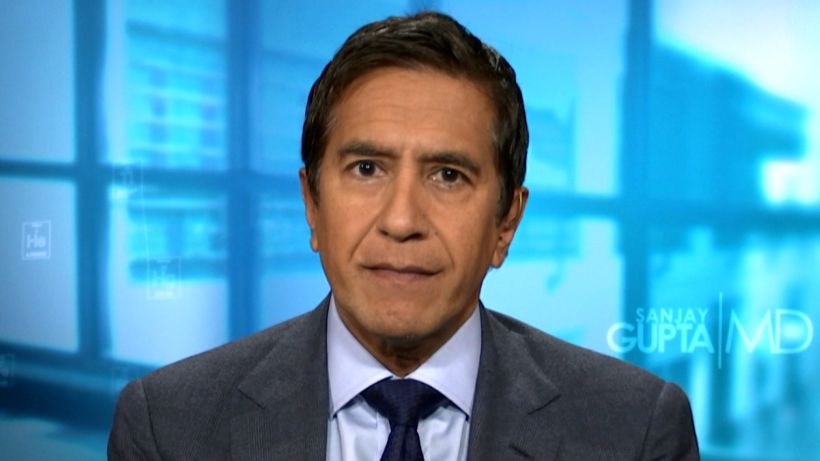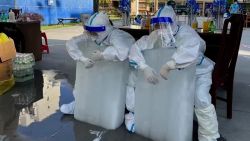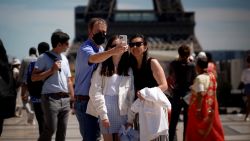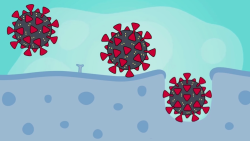The novel coronavirus that causes Covid-19 probably spread to people through an animal, and probably started spreading among humans no more than a month or two before it was noticed in December of 2019, according a new 120-page report from the World Health Organization.
But the search for the origin of the virus is ongoing.
“As far as WHO is concerned, all hypotheses remain on the table,” WHO Director-General Tedros Adhanom Ghebreyesus said in a statement Tuesday. “This report is a very important beginning, but it is not the end. We have not yet found the source of the virus, and we must continue to follow the science and leave no stone unturned as we do.”
The report, released Tuesday, lists four commonly discussed scenarios for the virus’ introduction to humans, including two it says are unlikely.
It says a scenario where the virus spread via an intermediate animal host, possibly a wild animal captured and then raised on a farm, is “very likely.” But the investigation has not found what other animal was infected by a bat – considered the most likely original source of the virus – and then may have transmitted it to a human. “The possible intermediate host of SARS-CoV-2 remains elusive,” the report reads.
Next likely is direct transmission from one of the animals known to carry a similar coronavirus, such as a bat or a pangolin.
The report says introduction through cold food products is considered a “possible pathway” and introduction through a laboratory incident was considered to be “an extremely unlikely pathway.”
The governments of the United States Australia, Canada, Czechia, Denmark, Estonia, Israel, Japan, Latvia, Lithuania, Norway, the Republic of Korea, Slovenia, and the United Kingdom jointly expressed concern about the World Health Organization (WHO) study into the origins of Covid-19 in China and called for independent and fully transparent evaluations with access to all relevant data in the future.
“We join in expressing shared concerns regarding the recent WHO-convened study in China, while at the same time reinforcing the importance of working together toward the development and use of a swift, effective, transparent, science-based, and independent process for international evaluations of such outbreaks of unknown origin in the future,” Tuesday’s joint statement said.
WHO scientists say they didn’t do ‘forensic examination’ of lab leak theory
The WHO report was written by a joint international team made up of 17 Chinese experts plus 17 experts from other countries, WHO, the Global Outbreak Alert and Response Network (GOARN) and the World Organization for Animal Health (OIE). The United Nations Food and Agriculture Organization of the United Nations (FAO) participated as an observer.
The original mission of WHO scientists was to study the animal origin of the novel coronavirus, which is why the new report does not provide the same depth of detail examining a lab leak theory, Peter Ben Embarek, a member of the WHO investigation team, said during a news briefing on Tuesday.
“The team was put together to do studies into the zoonotic origin of this virus,” Ben Embarek said, adding that this is the first time the scientists have been able to openly discuss the lab leak possibility.
“Now we have a process to discuss it – we have put it in our report,” Ben Embarek said. “Since this was not the key or main focus of the studies, it did not receive the same depth of attention and work as the other hypotheses.”
Still, the theory continues to draw attention. Former US Centers for Disease Control and Prevention Director Dr. Robert Redfield previously told CNN’s Dr. Sanjay Gupta in the documentary, “COVID WAR: The Pandemic Doctors Speak Out,” that his personal opinion was the virus was released from a lab in China, not necessarily intentionally.
Dominic Dwyer, another member of the WHO investigation team, said Tuesday investigators did have the opportunity to discuss a number of issues with the Wuhan Institute of Virology.
For example, investigators asked what about the lab’s biosecurity protocols in terms of handling material and the protocols for looking after the staff that work in the facility. Investigators all discussed with them about some of the testing they did on blood that is normally routinely collected from people who work in high-level security laboratories.
Dwyer said the lab had done antibody testing for evidence of the novel coronavirus and found those to be negative. They also had the opportunity to talk to the scientists in the laboratory about the type of work they were doing.
Dwyer also said the most closely related bat coronavirus to SARS-CoV-2, the virus that causes Covid-19, has not been isolated in a laboratory.
With that information, he said “I think we were satisfied that there was no obvious evidence of a problem, and that people had done the appropriate lookback to see how the laboratory had been functioning during that time.”
However, he noted, “A true forensic examination of a laboratory, like one might do, other types of forensic examinations, is a much more complex process, and that’s not what we’re there to do. So I think that’s important to remember.”
‘I expect future collaborative studies’
Ben Embarek said during the briefing that “frankly speaking” a lab leak theory was the first reaction many people had at the start of the coronavirus pandemic – but no firm evidence to support that theory has been found.
“Of course it’s possible and therefore it’s also part of the conclusions in the report that it’s not impossible,” Ben Embarek said “But we haven’t seen – or been able to hear or see or look at – anything that would warrant different conclusions from our side.”
Tedros said in prepared remarks that to understand the earliest cases, “scientists would benefit from full access to data including biological samples from at least September 2019.
“In my discussions with the team, they expressed the difficulties they encountered in accessing raw data. I expect future collaborative studies to include more timely and comprehensive data sharing,” Tedros added.
Privacy laws in China kept the WHO team from accessing as much data as possible on the origins of Covid-19 in Wuhan, Ben Embarek said on Tuesday.
Get CNN Health's weekly newsletter
Sign up here to get The Results Are In with Dr. Sanjay Gupta every Tuesday from the CNN Health team.
“Where we did not have full access to all the raw data we wanted, that has been put as a recommendation for future studies,” Ben Embarek said. “So the idea is that because we didn’t have time or because certain authorization needed to be given before we could get access to that data – all that will be and could be done in the second phase of the studies.”
Ben Embarek was unsure if or when WHO scientists will return to Wuhan for further study.
“That will depend how we organize the Phase 2 studies, how we plan them,” he said. “Some of them can be done quickly and with little resources – others will demand more time.”
CNN’s Sandi Sidhu, Maggie Fox, Jennifer Hansler and John Bonifield contributed to this report.





















